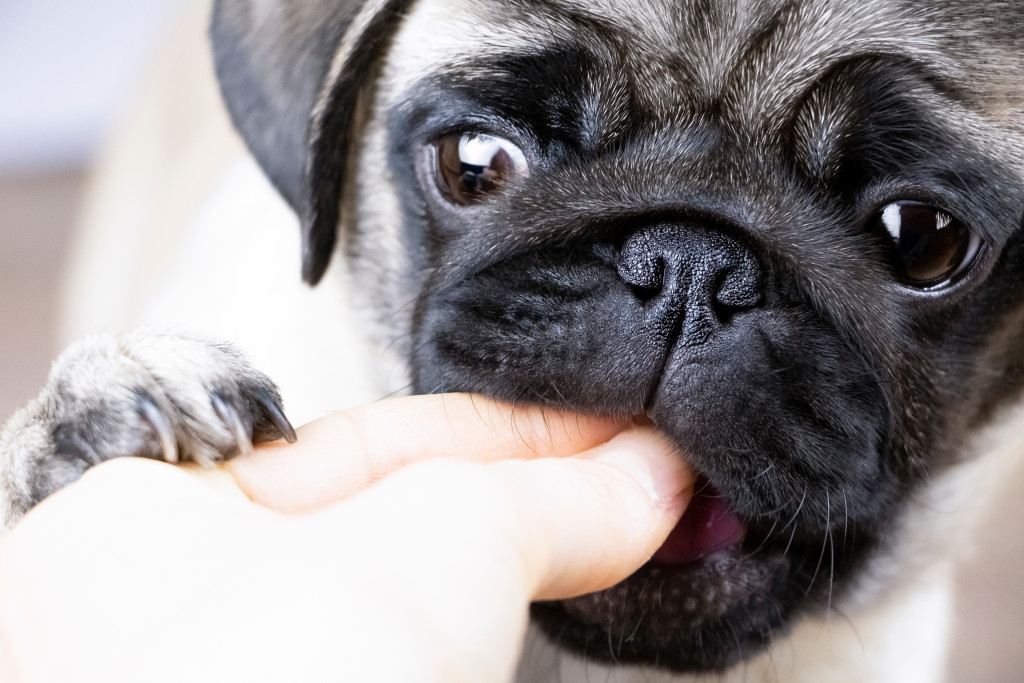A bite from your dog is dangerous. It can hurt, and it can wound someone emotionally. But did you know that dogs usually bite out of fear or because they feel threatened? Biting is common among dogs, and for them, it’s a normal reaction when they feel fear or threatened. It’s usually a form of aggression, a way to control their environment. So before preventing your dog from biting someone, you must understand how aggression works among dogs.
Aggression Among Dogs
Dogs are aggressive when they need to protect themselves or their pack. When they’re afraid, they might bite to defend themselves. Dogs might also be aggressive if they feel threatened or think their food is in danger. They might even become aggressive out of boredom or frustration. But no matter the reason, aggression is dangerous and can lead to bites. Of course, there are different types of aggression, too.
- Reactive aggression is when a dog bites in response to something happening. For example, a dog might bite if someone tries to take its food away.
- Proactive aggression is when a dog is aggressive without provocation. For example, this can happen when a dog feels threatened or is protecting its territory.
- Predatory aggression is when a dog bites to kill or seriously hurt its prey. This type of aggression is instinctual and usually can’t be prevented.
The best way to prevent your dog from biting someone is to understand its behavior and how to stop it before it happens. Here are five ways to do that:
Keep Them Socialized
Well-socialized dogs are less likely to bite. Socialization is exposing your dog to different people, places, and situations so it can learn to cope with them. The more exposure your dog has to different types of people and animals, the less fearful it will be. For example, you can take your dog to the park, on walks, and to dog parks.
You can also hang out with friends who have well-behaved dogs. Your dog can learn how to interact with other dogs appropriately.
Desensitize Them to Triggers
Some dogs might become aggressive when they’re touched in specific ways or when someone tries to take their food away. If you know what triggers your dog’s aggression, you can desensitize them. This means exposing them to the trigger in a non-threatening way until they no longer react aggressively. For example, if your dog becomes aggressive when someone tries to take its food away, you can gradually introduce people into its space while it’s eating. At first, keep the person at a distance, so your dog isn’t threatened. Then slowly move the person closer until your dog is comfortable with them being near its food.
You can also desensitize your dog to being touched by gradually touching it in the areas that make it uncomfortable. Start with non-threatening areas like the neck or back. Then slowly move to the more sensitive areas. If your dog shows aggression, move back to a less triggering area.

Use Positive Reinforcement
Positive reinforcement is rewarding your dog for good behavior. This can be treats, petting, or verbal praise. You can use positive reinforcement to teach your dog what behaviors are acceptable and which ones aren’t. For example, if you want your dog to stop jumping on people, you can ignore it when it does that behavior. But when it sits calmly, you can give it a treat.
Over time, your dog will learn that jumping on people isn’t rewarded, but sitting calmly is.
Redirect Their Energy
Dogs can become aggressive when they’re bored or have too much energy. Therefore, giving your dog enough exercise is essential, so it doesn’t get boring and lash out. You should also mentally stimulate your dog with games and training. This helps tire them out both physically and mentally.
Some games you can play with your dog include fetch, tug-of-war, and hide-and-seek. You can also teach your dog tricks or basic obedience commands. These activities help wear your dog out, so it’s less likely to become aggressive.
Get Them Trained
If all of these things fail, then you should get them trained. An experienced dog trainer can help you stop your dog’s aggression. They can also teach you how to manage your dog’s behavior better.
With the help of a trainer, you can learn how to desensitize your dog and use positive reinforcement properly. You’ll also learn how to redirect your dog’s energy and keep it stimulated.
Aggression in dogs is dangerous and can lead to bites. But with the proper training, you can prevent your dog from becoming aggressive in the first place.